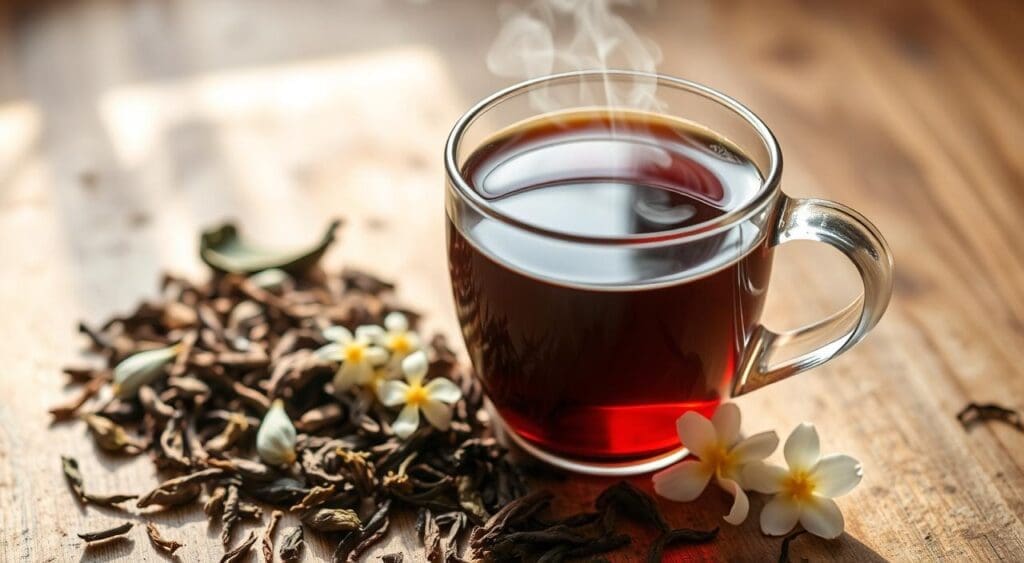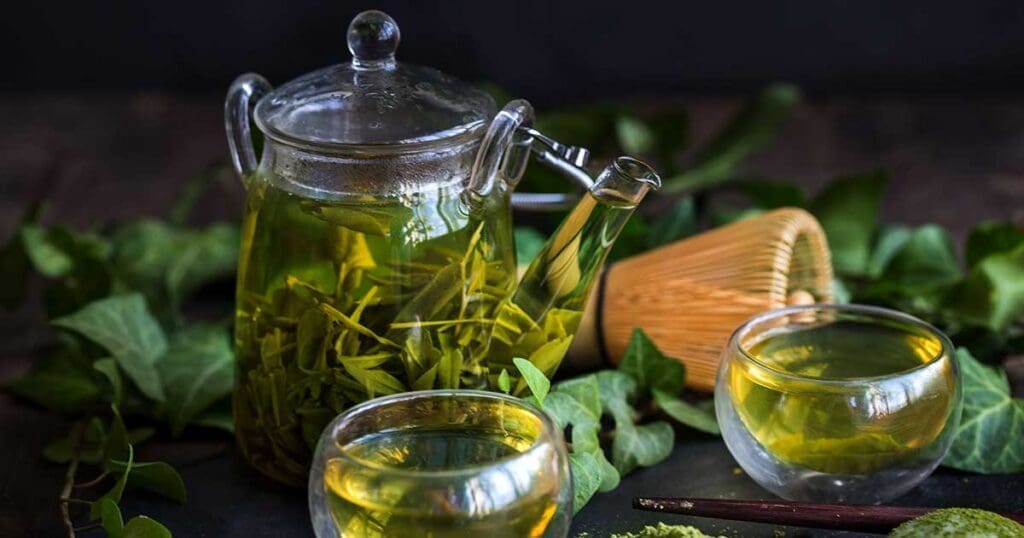Welcome to our guide to the world of tea. We'll explore the different types and their unique flavors. From black to white and green tea, we'll cover what makes each special.
We'll explore the vast world of tea, focusing on its flavors and characteristics. This guide is for both tea lovers and newcomers. It aims to show the unique qualities of each tea variety.
Introduction to Tea
Let's start our tea journey. We'll discover the rich diversity of tea flavors. Each type, from black to white and green, has its own unique character.
Key Takeaways
- We'll explore the different types of tea and their unique flavor profiles, including tea flavors.
- Our guide will cover the characteristics that set each type of tea apart, including Different Types of Tea and Their Flavor Profiles.
- We'll dive into what influences tea flavors, like production methods and regional differences.
- Whether you're a seasoned tea enthusiast or just starting out, this guide will help you navigate the world of tea.
- We'll give an overview of main tea types, like black, green, and white, and their distinct flavors.
- Our goal is to help you understand and appreciate the diverse world of tea and its many flavors.
Understanding the World of Tea: An Introduction
Exploring the world of tea, we find many tea categories. These include black, green, oolong, white, herbal, and yellow tea. Each has its own taste and making process. The way tea is made, like full oxidation or steaming, changes its flavor and keeps its health benefits.
The place where tea grows, called terroir, also shapes its taste. Like wine, the soil, weather, and height of the tea plants matter. To grasp tea, let's look at the six main types and how tea processing and terroir make them special.
The Six Main Categories of Tea
- Black tea: fully oxidized for a robust flavor
- Green tea: steamed or pan-fried to preserve natural antioxidants
- Oolong tea: partially oxidized for a complex taste
- White tea: minimally processed for a delicate flavor
- Herbal tea: not made from tea leaves, but from other herbs and plants
- Yellow tea: lightly oxidized for a smooth and refreshing taste
How Tea Processing Affects Flavor
The making process of tea changes its taste. Black tea's strong flavor comes from full oxidation. Green tea, on the other hand, is steamed or pan-fried, making it lighter and refreshing. Knowing how teas are made helps us enjoy their unique qualities.
Different Types of Tea and Their Flavor Profiles
The world of tea is incredibly diverse, with many types offering unique flavors. Green tea and black tea are two popular types. They have distinct flavors, making them versatile for tea lovers.
Green tea is known for its fresh, vibrant taste, often described as grassy or vegetal. Black tea, on the other hand, has a bold and robust taste. Its flavors can range from fruity to spicy. Both green and black teas vary in flavor based on their origin and production methods.
Some key characteristics of these teas include:
- Green tea: light, refreshing, and perfect for those looking for a subtle tea experience
- Black tea: rich, full-bodied, and ideal for those who prefer a stronger tea flavor
Exploring tea flavors means considering the many types of green tea and black tea. From Japanese green tea's delicate taste to Indian black tea's robust flavor, there's a tea for every taste.
Whether you like the subtle notes of green tea or the bold flavors of black tea, the variety is undeniable. Understanding the different types of tea and their flavors can lead you to find your perfect cup of tea.
Black Tea: The Bold and Robust Choice
Many tea lovers are drawn to black tea's robust flavors. It's known for its bold taste, making it great for those who like a strong cup. Black tea's popularity comes from its wide range of flavors, like Earl Grey's citrus and English Breakfast's malty notes.
Popular black teas include Earl Grey, English Breakfast, and Darjeeling. Each has its own taste. Earl Grey has a citrusy twist from bergamot, while English Breakfast is strong for a morning boost. There's a black tea for every taste preference.
Tasting Notes and Characteristics
Black tea is famous for its robust flavors and complex taste. Darjeeling offers sweet, floral notes, while Lapsang Souchong has smoky undertones. To enjoy black tea fully, pay attention to its tasting notes and characteristics.

Best Times to Enjoy Black Tea
The best time to drink black tea varies by personal taste. It's often enjoyed in the morning or early afternoon for a boost. Its robust flavors and aroma make it perfect for starting your day or taking a break. Black tea is great for any time, whether you prefer classic or exotic flavors.
Green Tea: Fresh and Vibrant Flavors
We love green tea for its fresh and vibrant flavors. This is thanks to its minimal processing. This keeps its natural antioxidants, which make it taste light and refreshing.
Green teas come from places like Japan and China. They have flavors ranging from grassy to slightly sweet. This makes them a top choice for those who prefer a lighter tea.
Some of the key characteristics of green tea include:
- High antioxidant content
- Light and refreshing taste
- Diverse range of flavors, including grassy and slightly sweet notes
Fresh flavors are a hallmark of green tea. Its vibrant aroma will surely tantalize your senses. It's perfect for relaxing or a refreshing pick-me-up.
Green tea is loved worldwide for its health benefits and flavors. It's a staple in many cultures. So, why not try a cup today and enjoy its fresh and vibrant flavors?
Oolong Tea: The Perfect Middle Ground
Oolong tea is a unique blend that stands out from other teas. Its partial oxidation creates complex flavors that can be floral, fruity, nutty, or honey-like.
The oxidation level greatly affects oolong tea's taste. We can divide oolong teas into light and dark types. Light oolongs taste more like green tea, while dark ones are closer to black tea. China's Ti Kuan Yin and Taiwan's Wuyi Oolong are famous for their unique tastes, showing oolong tea's wide range.
Light vs. Dark Oolong Varieties
Here are some key differences between light and dark oolong teas:
- Light oolong teas: floral and fruity flavors, similar to green tea
- Dark oolong teas: nutty and honey-like flavors, similar to black tea
Complex Flavor Development
Oolong tea's complex flavors come from partial oxidation. This process gives it a wide range of tastes. It's why oolong tea is loved by many tea lovers.
Regional Oolong Specialties
Some notable regional specialties include:
- Ti Kuan Yin from China
- Wuyi Oolong from Taiwan
These teas offer unique tastes that highlight oolong tea's complex flavors.
White Tea: Subtle and Delicate Notes
White tea is known for its delicate taste and light texture. It's a favorite among those who love a refined tea experience. Made from the young tea plant buds, it's harvested and processed lightly to keep its natural taste and smell.
White tea is packed with antioxidants, thanks to its minimal processing. This makes it a top pick for those looking for a healthy tea option. Its flavors are soft, ranging from sweet to floral, perfect for those who prefer a gentle tea.
Some of the key characteristics of white tea include:
- Light, silky texture
- Subtle flavors ranging from slightly sweet to floral
- High level of antioxidants
- Minimal processing to preserve natural flavor and aroma
Enjoying white tea is all about savoring its delicate notes and soft flavors. It's great on its own or with food. With its subtle flavors and health perks, it's a favorite among tea lovers.

In conclusion, white tea is perfect for those who want a delicate and refined tea. Its subtle flavors and health benefits make it a hit. So, why not try white tea and discover its unique qualities for yourself?
Herbal Tea: Caffeine-Free Alternatives
Herbal tea is a great choice for a calming drink any time of day. It's a caffeine-free option with many flavors and health benefits. Each type, like peppermint or chamomile, has its own special qualities.
Some popular herbal infusions include:
- Peppermint tea, known for its digestive benefits
- Chamomile tea, often consumed for its calming effects
- Hibiscus tea, rich in vitamins and minerals
These teas are tasty and good for you. We can enjoy them alone or mix them for new flavors. They're great for unwinding before bed or a morning boost.
Herbal tea is perfect for those who want a low-caffeine drink. Its health benefits make it a great part of our daily routine. It's a natural way to improve our well-being.
Tea Storage and Brewing Techniques
To enjoy the full flavor of teas, proper storage and brewing are key. Store tea in a cool, dry spot, away from sunlight and moisture. This keeps its taste and smell fresh.
The optimal temperature for brewing changes with each tea type. Black tea needs boiling water, while green and white teas prefer cooler water to avoid bitterness. Knowing the right steeping time for each tea is also important. Here's a quick guide for brewing techniques:
- Black tea: 200-212°F (93-100°C) for 3-5 minutes
- Green tea: 160-170°F (71-77°C) for 2-3 minutes
- White tea: 150-160°F (65-71°C) for 2-3 minutes
By following these tips and storing tea properly, you'll always have a great cup. The details, like the optimal temperature and brewing techniques, make all the difference.
With practice and patience, you'll get better at brewing and storing tea. Whether you're new to tea or a seasoned lover, we hope this guide helps you find your perfect cup.
| Tea Type | Optimal Temperature | Steeping Time |
|---|---|---|
| Black Tea | 200-212°F (93-100°C) | 3-5 minutes |
| Green Tea | 160-170°F (71-77°C) | 2-3 minutes |
| White Tea | 150-160°F (65-71°C) | 2-3 minutes |
Conclusion: Choosing Your Perfect Tea Adventure
We hope our journey through tea has inspired you to start your own tea adventure. There's a wide range of teas to try, from black tea's bold flavors to white tea's delicate notes. Oolong and herbal teas offer complex tastes, making tea a perfect fit for everyone.
Looking for a refreshing drink, a calming tea, or a new taste to explore? Tea has it all. It's a world full of possibilities for discovery and fun.
So, go ahead and brew a cup. Let the adventure start. Enjoy the unique aromas and colors. Each sip can reveal a new side of tea, maybe even your new favorite.
The beauty of tea is in its variety and flexibility. Try new things, explore, and discover the world of tea. It's a journey that will awaken your senses and broaden your taste. Whether you're a tea lover or just starting, there's always more to find and enjoy. So, raise your cup and celebrate the endless tea possibilities!
Disclaimer:
Some of the links on this site are affiliate links, which means I may earn a small commission if you make a purchase through them, at no additional cost to you. Thank you for supporting Brew Sip Repeat!




Facebook Comments